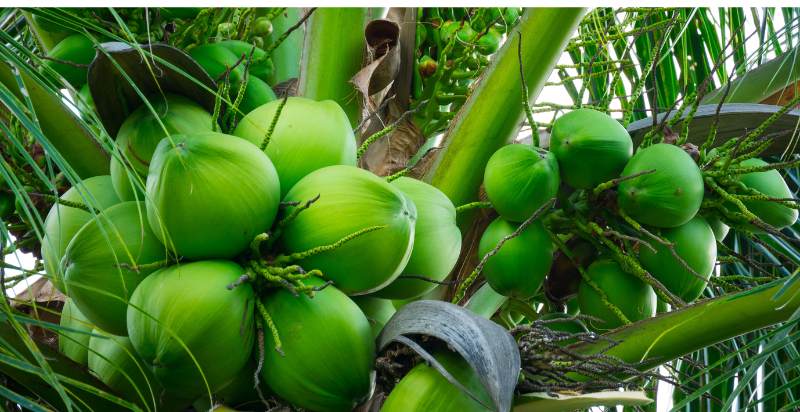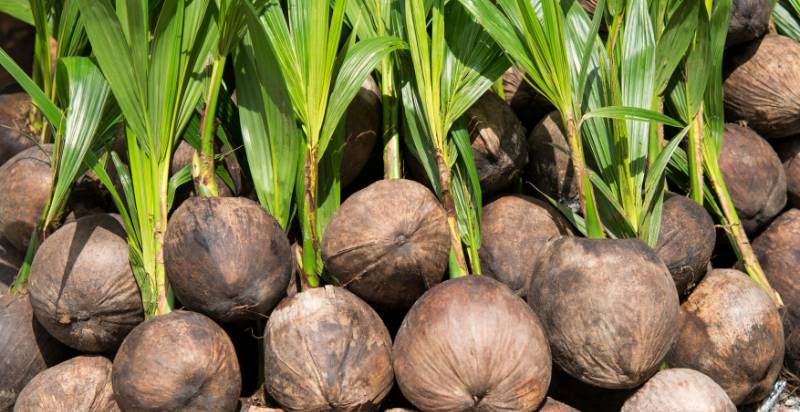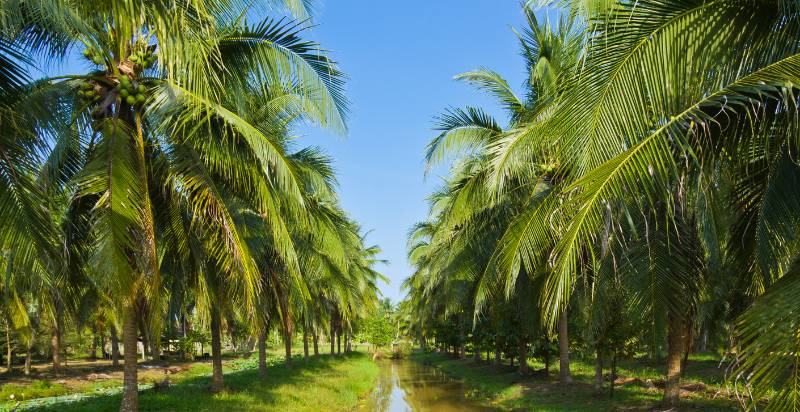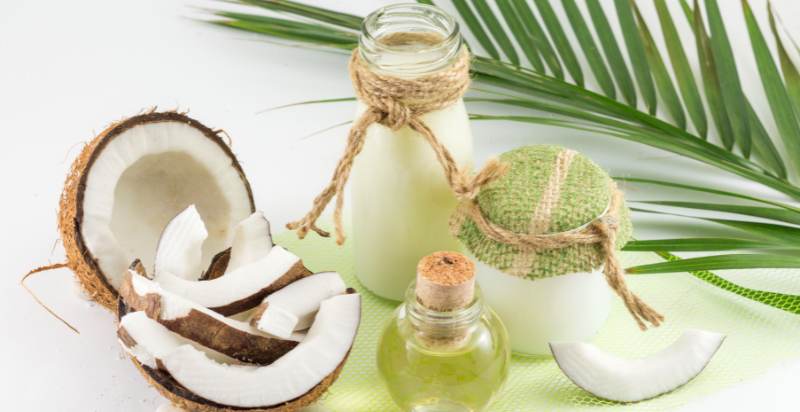In the Philippines, the coconut tree is dubbed as the “tree of life” for its many uses. When fully grown, it can provide a family with food, shelter, and a source of income. This blog post aims to discuss the proper way of planting and caring for a coconut palm. If you’re interested in learning more about this amazing tree, continue reading!
About Coconut Tree:
The coconut tree belongs to the palm tree family and is the only living species of the Cocos genus. The term “coconut” or “cocoanut” (old-fashioned spelling) can refer to the entire coconut palm, the fruit, or the seed. Botanically, the fruit is classified as a drupe and not a nut.
Coconuts are incredibly versatile as they can be used for various purposes such as food, fuel, cosmetics, rope, and even housing. Unlike other fruits, coconuts are unique because of their large quantity of “water.” When they are not yet fully matured, they are called tender nuts or jelly nuts, and they can be harvested for drinking. When fully matured, they still contain some water and can be used as seed nuts or processed to extract oil from the kernel. The hard shell can also be used to make charcoal, and the fibrous husk can be used to make coir.
Initially, the endosperm is in its nuclear phase and it’s suspended within the coconut water. As the development process continues, cellular layers of endosperm deposit along the walls of the coconut, which are thickened after the water is absorbed by the cells. Once dried, the exocarp and mesocarp form what is known as copra. It’s worth noting that while the FDA considers coconuts as tree nuts, they are not a common allergen.
History Of Coconut:
Coconuts were likely first domesticated in Southeast Asia or Oceania. Throughout history, they have been discovered in all tropical regions and have now also spread to subtropical areas like southern India, Pakistan, Sri Lanka, Iran, Hawaii, Florida, and the Carolinas in the United States.
The origin of coconuts is unknown because of a lack of genetic evidence. However, given their widespread distribution, it is probable that humans have known about coconuts for millennia and that they were an important item in early international trade.
Coconuts were first introduced to Europe by Portuguese explorers in the 16th century. Marco Polo gave the first detailed description of the coconut in his Travels; he described them as “a fruit with a hard rind or shell full of a sweet and excellent water.” Coconut oil soon became a common ingredient in European kitchens.

Name Origin Of Coconuts:
The term “coconut” is derived from the Spanish and Portuguese word coco, which translates to “head” or “skull.” This likely refers to the three indentations on the coconut shell, which resemble human eyes and a nose. The coconut palm’s scientific name is Cocos nucifera, and it belongs to the Arecaceae (palm) family. This plant is indigenous to Southeast Asia, India, and certain areas of the Pacific Ocean.
These are grown in tropical and subtropical areas around the world. They prefer sandy soils and need a constant supply of water. These are propagated by seeds, which take about 6-10 months to germinate. Once the seedlings have reached a height of about 2 m (6.6 ft), they can be transplanted into the field.
Description Of Coconuts:
Coconut palms can grow up to 30 m (98 ft) tall and have 4–6 m (13–20 ft) long, pinnate leaves. The leaflets are 2–3 cm (0.79–1.18 in) wide and 20–25 cm (7.9–9.8 in) long. The inflorescence grows from the leaf axils and comprises 10-20 spirally arranged flowers. The fruit is a drupe that measures 3–5 cm (1.2–2.0 in) in diameter and 7-8 cm (2.8-3.1 in) long, with a hard, fibrous husk surrounding the edible flesh and seeds.
These are monoecious, meaning that both male and female flowers are borne on the same inflorescence. The flowers are pollinated by wind or insects, and the fruits typically mature 9-12 months after pollination.
Different Types Of Coconuts:
There are two main types of coconuts: the tall variety (Cocos nucifera) and the dwarf variety (Cocos nucifera). The tall variety can grow up to 30 m (98 ft) tall and has long slender leaves. The dwarf variety is much shorter, only reaching a height of 5-10 m (16-33 ft), and has shorter, broader leaves.
The two varieties also differ in the size and shape of their fruit. Tall coconuts are larger and more oval, while dwarf coconuts are smaller and more round.
The different types of coconuts are used for different purposes. Tall coconuts are mostly used for producing coconut oil, while dwarf coconuts are used to manufacture desiccated coconut, coconut milk, and creamed coconut.
Health Benefits Of Coconuts:
Coconuts are a good source of dietary fiber and contain vitamins C, E, B1, B3, B5, and B6. They also contain minerals such as iron, selenium, sodium, calcium, magnesium, and phosphorus.
The health benefits of coconuts include supporting heart health, improving digestion, helping to prevent cancer, and promoting weight loss. Coconut oil also treats skin conditions such as psoriasis and eczema.
It is made up of medium-chain fatty acids (MCFAs), a type of saturated fat metabolized differently than other types of fat. MCFAs are absorbed directly by the liver and used for energy rather than stored as fat.
Cultivation of Coconuts:
Coconut palms are grown in tropical and subtropical areas around the world. They prefer sandy soils and need a constant supply of water. These are propagated by seeds, which take about 6-10 months to germinate. Once the seedlings have reached a height of about 2 m (6.6 ft), they can be transplanted to their permanent location.
It takes about 5-6 years for a coconut palm to start bearing fruit, and it can produce fruit for up to 80 years. A single tree can produce 50-200 coconuts per year.
Seasonality and Availability of Coconut Tree:
Coconut trees flourish in the warmest regions of the United States, such as parts of Florida, Hawaii, and the country’s tropical territories. These areas provide the perfect conditions for coconut trees to thrive: consistently mild temperatures, ample sunlight, and high humidity, closely resembling their natural tropical environment. In these optimal growth zones, coconut trees bear fruit year-round, ensuring a steady supply of coconuts. The peak harvesting seasons may vary slightly depending on local weather patterns and the type of coconut palm being cultivated.
However, outside these warm, tropical areas, growing coconut trees becomes more challenging. The cooler temperatures and lower humidity levels found in most of the continental U.S. are not conducive to coconut production. While it’s possible to grow coconut trees in some of the warmer, borderline climates, these trees often struggle to bear fruit or mature fully. As a result, the U.S. market for coconuts relies heavily on imports from other countries where the climate is better suited for coconut cultivation. This means that, despite the limitations on local production, consumers across the U.S. have access to coconuts year-round, thanks to the global trade in this versatile fruit.
Economics of Coconuts:
The global production of coconuts was about 61 million tonnes in 2015, with Indonesia (19 million tonnes) and the Philippines (18 million tonnes) being the leading producers. Other major producing countries include India, Brazil, Sri Lanka, Thailand, and Vietnam.
Coconut oil is the main commercial product from coconuts and is used in a wide range of food and non-food products. Other products made from coconuts include desiccated coconut, coconut water, coconut milk, and creamed coconut.
The husks and shells of coconuts can be used to make fuel, activated carbon, potash (from the ashes), or processed into fiber used in brushes, ropes, mats, nets, and upholstery stuffing.
Coconuts are an important crop in many countries and provide a significant source of income for small farmers and rural communities. In some areas, such as the coastal regions of Kerala in India, coconuts are a staple food and an important part of the local diet.
Uses of Coconuts:
Coconuts are versatile fruits that can be used in various ways. The water inside it is a refreshing drink and can also be used for cooking. The flesh of the coconut can be eaten fresh or dried and used in a variety of dishes. Coconut oil is extracted from the flesh of the coconut and has a wide range of uses, including cooking oil, hair oil, body lotion, and industrial applications.
The hard shell of the coconut can be used to make bowls, cups, or other utensils, or it can be burned to create charcoal. The fiber from the coconut (coir) husk is used to make ropes, mats, brushes, and other products.
These are also grown for their ornamental value and can be used as landscape plants or street trees.

How to Grow Coconut Tree?
The following sections will give you everything you need to know about growing and maintaining your coconut palm tree.
Now looks at step by step guide on how to do it:
Coconut palms are grown in tropical and subtropical areas around the world. They prefer sandy soils and need a constant supply of water. These are propagated by seeds, which take about 6-10 months to germinate. Once the seedlings have reached a height of about 2 m (6.6 ft), they can be transplanted into the field.
The ideal spacing between coconut palms is 10 m (33 ft) apart, but they can be planted closer together if necessary. It will begin to produce fruit after 4-5 years and will continue to bear fruit for 20-30 years. A single palm can produce 50-200 coconuts per year.

Fertilizer
Coconut palms are not heavy feeders but will benefit from regular applications of fertilizer, especially during the fruiting season. A balanced fertilizer such as 8-8-8 or 10-10-10 can be applied monthly at a rate of 1 lb per year of age up to 10 years, then 1/2 lb per year after that. For example, a 3-year-old tree would receive 3 lbs of fertilizer per month during the fruiting season.
Watering
Coconut palms need plenty of water but cannot tolerate flooding. They should be watered deeply and evenly, allowing the soil to dry out slightly between waterings. If the leaves start to turn yellow, this is a sign of water stress and the tree needs to be watered more frequently.
Pruning
Coconut palms do not require pruning, but dead or damaged leaves can be removed. It is also important to remove any suckers that appear at the base of the tree, as these can compete with the main trunk for nutrients and water.

Pests and diseases
Coconut palms are susceptible to various pests and diseases, including scale insects, mites, nematodes, and fungi. These can cause serious damage to the trees and reduce yields.
These are also affected by storms and high winds, which can break off the branches or uproot the trees.
Harvesting
Coconuts can be harvested year-round but are typically ripe 9-12 months after pollination. The fruits will fall to the ground when they are ready to harvest. To determine if a coconut is ripe, shake it and listen to the sound of water sloshing inside. You can also crack open the husk to check the color of the meat – it should be white or cream-colored.
Cut the stem with a sharp knife or machete to harvest a coconut. Be careful not to damage the trunk of the tree. You can then crack open the husk and remove the flesh and seeds. The flesh can be eaten fresh or dried, and the milk can be used to make coconut oil.

How To Eat Coconuts?
Coconuts can be eaten fresh, dried, or in the form of coconut milk or oil. Fresh coconuts should be refrigerated and used within a few days.
To open a fresh coconut, make two holes in the “eyes” at one end of the shell with a screwdriver or knife. Turn the coconut upside down over a bowl and allow the water to drain out.
Use a hammer or mallet to tap around the circumference of the shell until it cracks open. Remove the white flesh from the shell and cut it into pieces. The flesh can be eaten fresh or used in recipes.
Dried coconuts can be stored at room temperature and used as needed. To rehydrate dried coconut, soak it in water for several hours or overnight.
Coconut milk and coconut oil can be found in the aisle of most grocery stores. Coconut milk is made by blending the flesh of the fresh coconut with water. It can be used in recipes or enjoyed on its own in place of dairy milk.
Its oil can be used for cooking or added to smoothies, salad dressings, and other recipes. It can also be applied topically to skin and hair.
The Different Ways To Use Coconuts:
Coconuts can be used in sweet and savory dishes and for cosmetic and health purposes.
Some popular ways to use coconuts include:
- Adding coconut milk or cream to curries, soups, and stews
- Using coconut oil for cooking or baking
- Making homemade coconut yogurt
- Adding shredded coconut to granola or oatmeal
- Using coconut flour to make Paleo-friendly desserts and baked goods
- Applying coconut oil to skin and hair as a natural moisturizer
Coconuts are versatile ingredients that can be used in many different ways. Try incorporating them into your diet and see how they benefit your health!

Potential Allergies From Coconut:
Coconut oil has been criticized for its high saturated fat content. However, recent studies have shown that coconut oil can improve cholesterol levels and reduce the risk of heart disease.
Coconut palms are also a source of environmental pollution, as they produce large amounts of methane gas, which is a greenhouse gas that contributes to global warming. In addition, clearing land for its plantations can lead to deforestation and loss of habitat for wildlife.
Conclusion
Coconuts are nutritious and versatile fruits that offer many health benefits. They can be eaten fresh, dried, or in coconut milk or oil. Coconut oil also treats skin conditions such as psoriasis and eczema. Try incorporating coconuts into your diet and see how they can benefit your health!
- Everything You Wanted to Know About Red Tamarillos - June 2, 2025
- A Guide to Tulips: Everything You Need to Know & More… - June 2, 2025
- Guanabana: Description, Flavor, Benefits, And Uses - May 27, 2025

4 thoughts on “Coconut Tree: Growing and Maintaining a Coconut Palm”
Comments are closed.